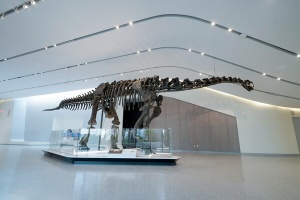Cleveland Museum of Natural History Unveils New Visitor Hall

The Cleveland Museum of Natural History celebrates the next step in its current transformation and expansion as eight of our most iconic attractions return to exhibit. They will now be featured in our Visitor Hall.
The 14,650-square-foot Visitor Hall features specimens placed along a timeline reflecting milestones in the history of the Universe. The timeline is funded by Museum Board Member Doug McCreery and his wife, Dr. Laurie McCreery.
According to Museum President & CEO Sonia Winner, “The Museum has always been a valuable resource to our city, our region, and the world. We are excited to celebrate the return of our Museum’s most beloved specimens in a community space that is free to all visitors. This is an exciting milestone in our transformation that has been in the making for 20 years. We now have a little more than a year until we unveil the Museum’s new wings and the completely reimagined exhibits that will put our guests at the center of the experience.”
Special Days Mark the Debut of the Visitor Hall
Saturday, October 14 is reserved for a Museum member preview.
On Sunday, October 15, the Visitor Hall opens to the public for the first time. Every Sunday, residents of Cleveland and East Cleveland are invited to visit the Museum free of charge during the Jack, Joseph and Morton Mandel Community Days.
Returning Icons Showcased in a New Way
ADVERTISEMENT
Our iconic sauropod, Haplocanthosaurus delfsi, known as “Happy,” is a holotype specimen for the species H. delfsi. Happy was discovered by a Museum team in 1954 in Colorado and is the most complete adult specimen of its kind.
Lucy, the world-famous, 3.2-million-year-old partial fossil skeleton of the species Australopithecus afarensis, was discovered in Ethiopia in 1974 by Dr. Donald Johanson, a former curator at the Museum.
Dunk, or Dunkleosteus terrelli, is a giant armored fish that was one of the fiercest creatures alive three hundred and fifty-eight million years ago.
Balto, the lead dog of a 1925 team of sled dogs that traveled 674 miles to deliver lifesaving medicine to a remote area of Alaska. Balto’s new showcase is sponsored by The Milton and Tamar Maltz Family Foundation.
The Museum’s iconic Moon Rock, on long-term loan from NASA.
A model of a Bald Eagle—an important reminder that the Museum pioneered a successful bald eagle breeding program in the 1970s.
A dramatic window of Butterflies represents the Museum’s important Invertebrate Zoology collection—housing approximately 1 million specimens.
The Jeptha Homer Wade II Collection of Gems & Jewels. The display is representative of the Museum’s Mineralogy assets, including materials from the Earth (rocks and minerals) and beyond (meteorites).
The redesigned exhibits, developed by G&A (Gallagher & Associates) in tandem with the Museum’s curatorial, collections, and educational teams, will take a new approach to natural history, avoiding traditional compartmentalization by time period, geography, and types of living things to form integrated storylines of planetary and biological processes and make these powerful forces tangible and relevant to contemporary life.
The Museum has trusted the realization if its transformation to the careful efforts of Panzica Construction and the integrated design work of DLR Group. DLR Group’s visionary work includes several phases of renovation and an addition that will enhance exhibit, educational, and gathering spaces. New, renovated, and reorganized exhibit spaces will expand programming and reimagine the presentation of the Museum’s world-renowned collections. Inspired by the Museum’s commitment to sustainability and its relationship with surrounding bodies of water, the design creates a single and continuous form that ties together current and previous additions.
“DLR Group is honored to be partnering with the Cleveland Museum of Natural History on this multiphase transformation,” said DLR Group Principal and Global Architecture Leader Joshua Haney, AIA. “The Visitor Hall acts as a welcoming and inclusive haven for museum visitors to step in and discover captivating exhibits and interactive opportunities that broaden their understanding of the natural world both within and beyond the city of Cleveland.”
This multi-phased transformation project builds upon the firm’s decades-long relationship with the Cleveland Museum of Natural History dating to 1955. The reimagine of the Museum includes upgrades to collections and exhibit areas, research spaces, offices, and classrooms, reorganization of all public galleries, and consolidation of all collection storage.
The following programs will premiere on Sunday, October 15:
Flight of the Butterflies follows monarch butterflies on their migration—presented in 3D.
Titanosaur 3D focuses on the largest animal to ever walk the Earth.
Eclipse Fever, a new show in the world-class Nathan and Fannye Shafran Planetarium, will explore a total solar eclipse.
Nesting: Images by Judith McMillan explores birds’ nests as architecture. McMillan is an American artist and a Museum board member.
Community Spaces in the Museum
The Visitor Hall is a community space to visit free of charge
Origins Café, the Museum’s café managed by Levy
The Leonard Krieger Fund Café Terrace, featuring indoor and outdoor seating
The new Museum Store
Steggie, the Stegosaurus sculpture in front of the Museum.
During this phase in our transformation, general admission will give guests access to:
The Smead Discovery Center—Presented by PNC, encouraging learning for children,
Live Astronomy presentations in the world-class Nathan and Fannye Shafran Planetarium,
3-D movies in the Museum’s Murch Auditorium,
The Thelma and Kent H. Smith Environmental Courtyard,
The Ralph Perkins II Wildlife Center & Woods Garden—Presented by KeyBank, and
Corning Gallery’s rotating exhibits.

